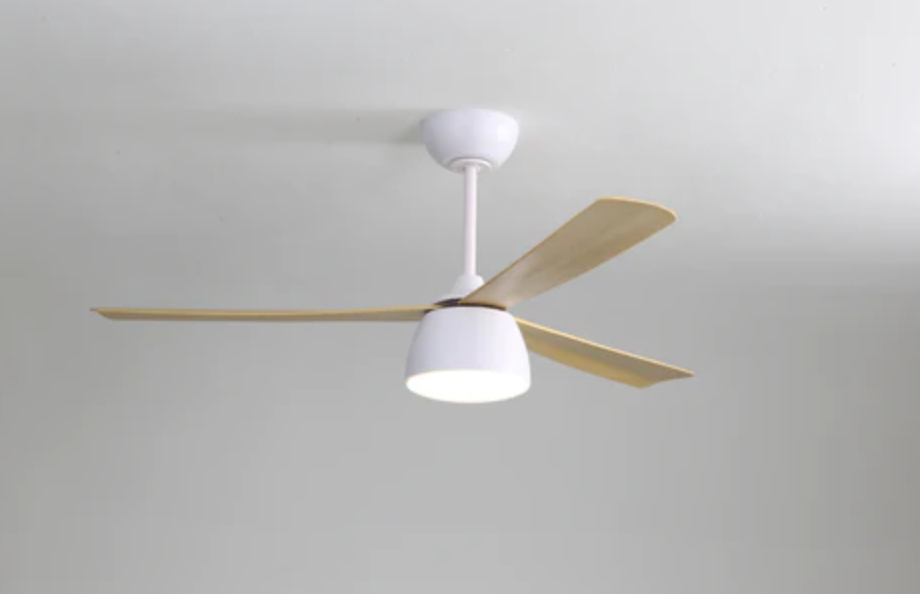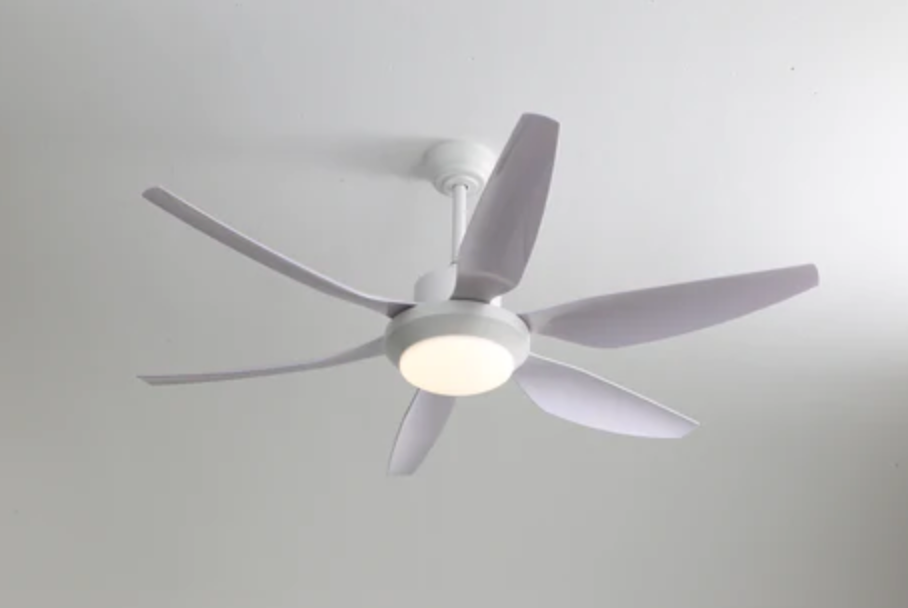
How to wire a ceiling fan with light
If you have purchased a ceiling fan and light fixture, you may need to wire them together. This can be done relatively easily with the right tools and supplies.
First, turn off power going to the room where you are wiring the fan and light. Locate the electrical box in your ceiling that will house all of the wiring for the fan and light. This box should have a metal or plastic cover that can be removed to access the wires.
Next, identify the black (hot), white (neutral) and green (ground) wires coming from your ceiling fan. Depending on the type of fan you purchased, these could all be connected together in one section of the box or separated into individual wires.
Attach the house's black wire, typically coming from a switch in your wall to the fan's black wire, and attach the house's white wire to the fan's white wire. If you have a green ground wire for your ceiling fan, connect it to any of the exposed metal parts in your box.
Now, it is time to connect the light fixture wires to the fan's wiring. Connect the black wire from your light fixture to the blue wire coming from your fan. Connect the white wire from your light fixture to the white wire coming from your fan and then attach a separate ground wire directly to any metal part of the ceiling fan or light fixture.
Once all the wires have been connected, you can put your cover back on and turn the power back on in the room. You should now be able to use both your ceiling fan and light!
If you are unsure about any part of wiring a ceiling fan with a light, it is best to contact a local electrician for assistance. They will have the knowledge and expertise to ensure your fan and light are wired correctly.
That's it! You should now be able to enjoy your new ceiling fan with light. Congratulations! It is a great addition to any room and can help save energy by circulating the air in your home. Enjoy!
Why is my ceiling fan not working but the light works?
If your ceiling fan lights are working but the fan itself isn't, the most likely issue is that the fuse has blown. Ceiling fans have a built-in fuse that helps to protect the motor from power surges. Over time, this fuse can become damaged and need to be replaced.
Why is my ceiling fan not turning in?
If your fan isn't turning properly, or one or more of your speed control settings isn't working, use these ceiling fan troubleshooting tips: Step 1: Locate the ball bearings and give them a good cleaning. Add lubricant to ensure proper rotation. Step 2: Replace the ceiling fan capacitor.
Congratulations on completing the installation of your ceiling fan with light! If you followed the instructions here, you should have been able to safely wire up your new ceiling fan with light. If you are still having difficulty, or if you have any other questions about wiring your ceiling fan, contact a professional electrician for assistance. With the proper installation, you can enjoy your new ceiling fan and light for many years to come.
People also ask these questions
The ceiling is of poor quality. Can we install ceiling fan lights?
Ceiling quality is one of the important considerations when installing ceiling fan lights. If the ceiling quality is poor, it may affect the safety and stability of the ceiling fan lights. The following considerations and actions are recommended before installing ceiling fan lights:
Check ceiling structure: Before installing ceiling fan lights, make sure the ceiling structure can support the weight of the ceiling fan lights. The ceiling should be strong and stable enough to support the weight and operation of the ceiling fan light.
Find the installation location: Determine the appropriate installation location to ensure that the ceiling provides adequate support. Install ceiling fan lights in structurally sound ceiling areas to ensure their safety and stability.
Use load-bearing supports: For poor quality ceilings, consider using load-bearing supports. The bearing support increases the supporting area of the ceiling fan light and distributes the weight, thus improving the installation stability.
Seek professional help: If you are unsure about the quality and construction of your ceiling, or if you are not familiar with the installation of ceiling fan lights, it is recommended to consult a professional such as an electrical installer or decoration specialist. They can provide accurate advice and installation instructions to ensure the safe and efficient operation of ceiling fan lights.
In short, poor ceiling quality may have an impact on the installation of ceiling fan lights. Before installation, ensure that the ceiling is structurally sound and take appropriate safety measures to ensure the safety and stability of the ceiling fan lights.
Is it good to install ceiling fan lights in the kitchen?
Installing ceiling fan lights in your kitchen can bring some benefits, but there are also factors to consider. Here are some considerations for installing ceiling fan lights in your kitchen:
Ventilation and venting: The kitchen is an area that generates heat and steam, equipped with ceiling fan lights to provide additional air circulation and ventilation effects. Ceiling fans can help draw hot air and smoke out of the room, reducing soot and odor retention and improving air quality.
Cooling effect: Ceiling fan lights can create airflow when running, bringing a breeze effect, helping to reduce the body temperature of the kitchen. This makes working in the kitchen more comfortable on a hot day.
Lighting function: Ceiling fan lights are often combined with lighting function to provide basic lighting needs. In the kitchen, good lighting is very important to improve productivity and safety.
Use of space: Kitchens tend to be one of the busier areas of the house, so installing ceiling fan lights in the kitchen can save space, as they take up less space than traditional chandeliers.
However, there are some factors to consider:
High temperature and oil fumes: High temperature and oil fumes in the kitchen may affect the electrical components of ceiling fan lamps. Choose ceiling fan lights that resist high temperatures and are easy to clean to improve their durability and reliability.
Safety: Ensure that ceiling fan lights are installed at a position and height that does not collide with personnel or cooking equipment in the operating area. Follow proper installation guidelines and ensure that it is mounted safely and reliably on a sturdy ceiling structure.
Maintenance and cleaning: Ceiling fan lights can be more difficult to clean than traditional chandeliers due to their height and rotating parts. When choosing ceiling fan lights, consider ease of cleaning and maintenance and choose models that are easy to remove and clean.
How to pull out ceiling fan lamp leaf
1. If you want to pull out the fan blade of the ceiling fan lamp, you can turn on the 1 fan by switching, and the fan blade of the chandelier fan will automatically come out; If we want to clean the blades, we just drag the shrinking blades out. Ceiling fan lights on the market are generally divided into rope, remote control, wall control three kinds of switches in which lamps and fans do not affect each other, separate control.
2. Ceiling fan lamp is a combination of lamps and fans, with diverse styles and good decoration; And the ceiling fan light is practical, with positive and negative switches, can be used in summer and winter, but also has the advantages of energy saving, quiet and so on. However, if you want to install ceiling fan lights, try not to install ceiling, so that the space will not look depressed. Ceiling fan lights in use, there will be a slight sense of dazzling.

3. We also need to pay attention to the cleaning and maintenance of ceiling fan lamps in daily life. For example, we can mix white vinegar and water in proportion, put the rag into it and then dry it out, and wipe the fan leaf lamps and lanterns. If there are stubborn stains on the surface of the ceiling fan lamp, use a toothbrush with kerosene to scrub, and then use dishwashing liquid to clean the residual kerosene.
4. After the ceiling fan lamp has been used for one year, check whether the hanging position of the ceiling fan lamp is firm, and whether the boom, screws, blades and other components are loose or damaged. If so, repair and replace the ceiling fan lamp in time. When you use ceiling fan lights, you can first test run. During the trial run, no one should be under the ceiling fan lamp. If the ceiling fan lamp is found to have abnormal sound, uneven rotation and other problems, it should be stopped for maintenance immediately.
To sum up
Installing ceiling fan lights has some benefits in the kitchen, but it also requires a comprehensive consideration of factors such as ventilation needs, space utilization, safety and maintenance.


